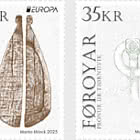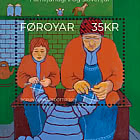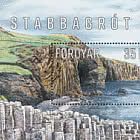- Home
- Stamps
- Faroe Islands
- 2022
Christmas & Advent
The Advent wreath
The first candle in the Advent wreath is lit on the first Sunday in Advent. On the second Sunday of Advent, two candles are lit - three on the third - and finally, on the fourth Sunday of Advent, all four candles have been lit. This is a beautiful and relevant tradition, where the number of candles increase in step with the growing darkness of winter, culminating around winter solstice and Christmas.
However, the Advent wreath tradition is not as old as one might think. It is attributed to the German theologian Johann Hinrich Wichern (1808-1881), the founder of the Inner Mission, who, in addition to his missionary work, performed social work among the poor and vulnerable in urban environments in Germany.
When the children in “Rauhes Haus”, the Mission School in Hamburg, persistently asked how many days there were left to Christmas, Wichern put four large white candles on an old wagon wheel and placed 20 smaller red candles in between. The large candles symbolized the four Advent Sundays before Christmas - and the small ones the weekdays in between. This became a school tradition and in 1860 J. H. Wichern started covering the wheel with spruce twigs - reportedly because they reminded him of the crown of thorns on Christ the crucified.
The custom spread in Germany and beyond its borders. The Advent wreath became common in Denmark during World War II and from there the custom probably arrived in the Faroe Islands.
The Christmas tree
One of the most iconic Christmas traditions is the decorated Christmas tree - most often the evergreen spruce, which is placed in the living room and embellished with the family’s Christmas decorations - candles, braided hearts, paper cones, coloured balls, stars and maybe a few angels and angel hair, usually with a large star at the top - the Tree of Life, as it were, crowned by the Star of Bethlehem.
Just like the Advent wreath, the tradition of the Christmas tree in its present form originates in Germany. Artisans’ guilds in Germany began arranging Christmas parties for children in the 16th century, possibly with an eye on older traditions. The centrepiece of the party was a decorated spruce tree with gifts for the children. The custom spread and soon the bourgeoisie began placing a decorated Christmas trees in their living rooms during the festive season. In 1632, a mention of lighted candles on Christmas trees can be found for the first time in a written source - a custom which is still retained and revered. However, due to the peril of fire lighted candles have been replaced with electric light sources.
The Christmas tree spread its branches beyond Germany’s borders. According to sources the first Danish Christmas tree was probably introduced in 1808 at the Holsteinsborg estate in South Zealand. The custom spread among the clergy and bourgeoisie in the 19th century and was disseminated widely around World War I.
In the Faroe Islands, the first Christmas tree reportedly found its way to the Sandagerð Rectory in Tórshavn, just before the turn of the 20th century. Here, too, the custom slowly spread among the clergy and the bourgeoisie, perhaps especially among Danish officials in Tórshavn. In an advertisement in the newspaper “Dimmalætting” in 1912, the florist Trond-Hansen offers Christmas trees for sale at 35 øre pr. tree.
During World War II, it became difficult to obtain Christmas trees, so people had to use their imagination. Artificial Christmas trees, composed of various items, fallen branches and other available material, were commonly used. Only after the war in the 50’s, the Christmas tree tradition had a breakthrough among the general population.
The motifs
This year’s Christmas stamps depict the Advent wreath (19KR) and the Christmas tree (29KR), respectively, both with lit candles. The artist, Heiðrik av Heygum, explains his inspiration for the motifs:
“I received a request to design two Christmas stamps inspired by the story of the Faroese Advent wreath and the Christmas tree. The Christmas tree and the Advent wreath are relatively recent traditions in the Faroe Islands, almost as fresh to us as the Faroese visual arts.
The Faroese embraced these beautiful Christmas traditions - the Advent wreath around the 1940’s and the Christmas tree in the early 1900’s. A few years later, Faroese visual art began to flourish in earnest. Artists such as William Heinesen and Elinborg Lützen attracted attention and have immensely influenced Faroese visual identity. All Faroese have grown up and become thoroughly acquainted with their two-dimensional illustrations of Faroese legends and adventures in clips and prints.
Christmastide is a traditional, reflective and nostalgic celebration and very close to our hearts. Therefore, I thought it would be appropriate to depict our Christmas traditions in a traditional way, while also paying tribute to William’s and Elinborg’s visual styles.”
Anker Eli Petersen
Faroe Islands - Recommended stamp issues
WOPA+ recommended stamp issues
| Avatar - Fire and Ash |
| Issued: 03.12.2025 |
| ›New Zealand |
| 50th Anniversary of the Founding of the 24th November Bar Scout |
| Issued: 24.11.2025 |
| ›Montenegro |
| Krisjanis Valdemars |
| Issued: 02.12.2025 |
| ›Latvia |
| Sign Language - Good |
| Issued: 02.12.2025 |
| ›Bosnia and Herzegovina - Republic of Srpska |
| In Memory of the Fallen and Murdered on October 7, 2023 |
| Issued: 08.10.2025 |
| ›Israel |
| Annual Collection Folder (New York) |
| Issued: 05.12.2025 |
| ›United Nations |
| Year Set |
| Issued: 24.11.2025 |
| ›Isle of Man |
| Shipping in the 17th and 18th Centuries - Peat Shipping |
| Issued: 05.12.2025 |
| ›Netherlands |

















































